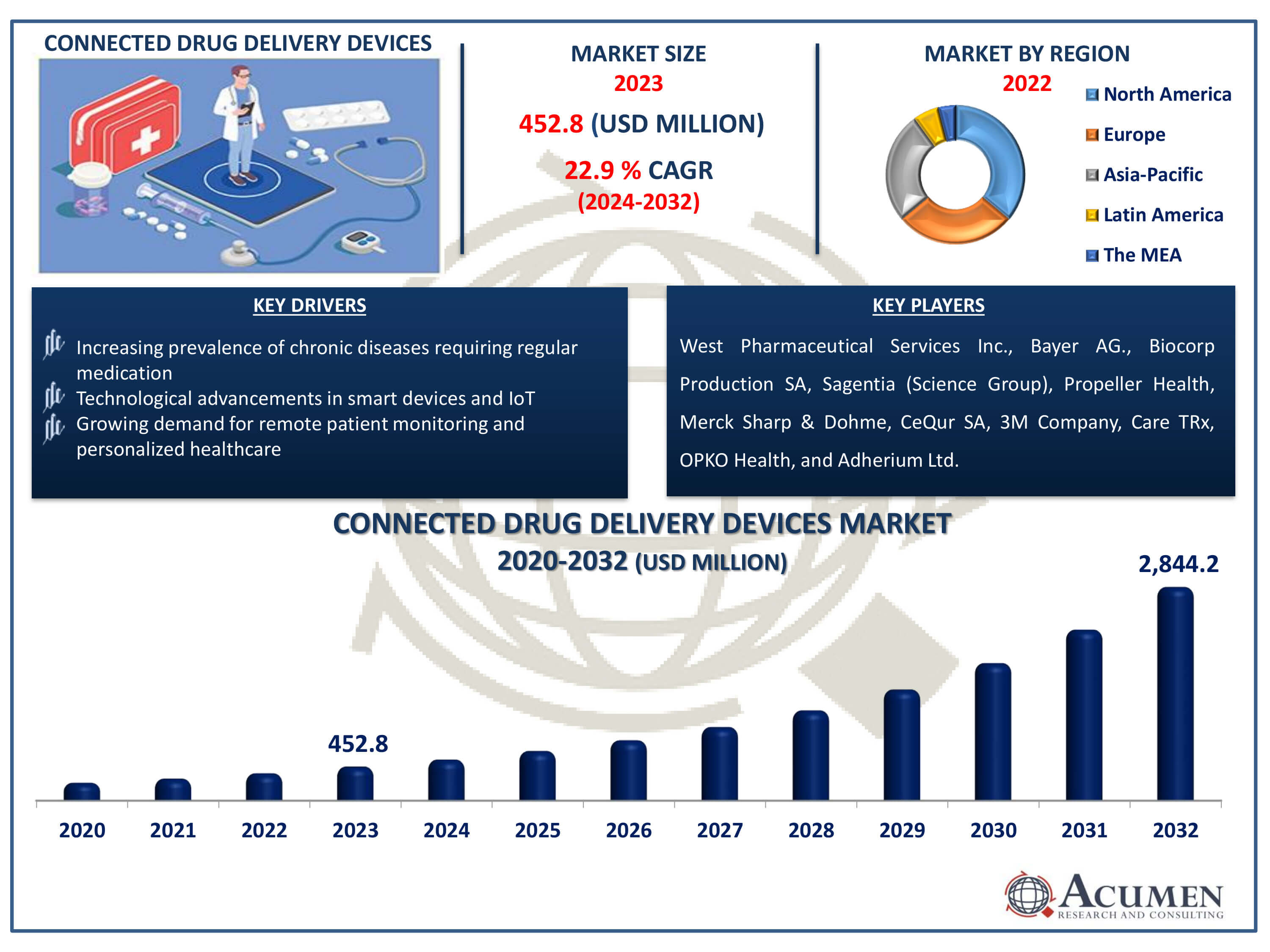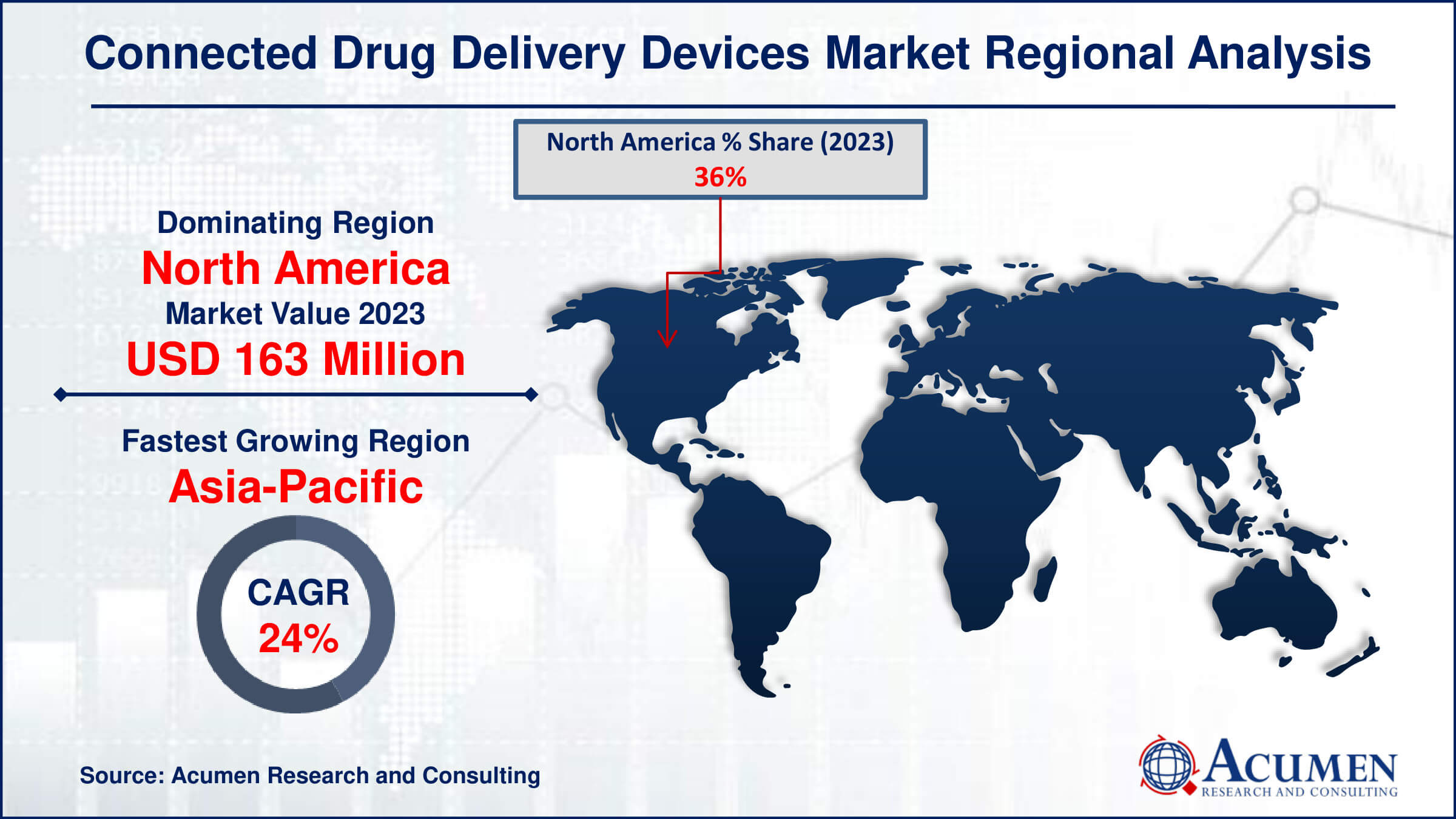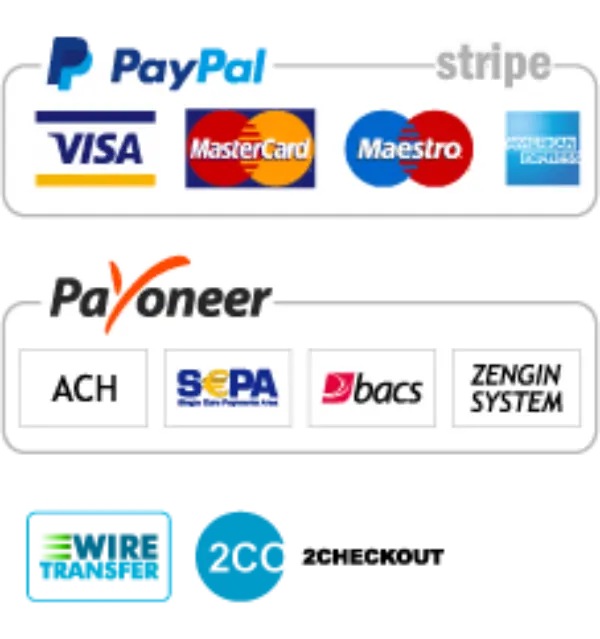Connected Drug Delivery Devices Market Size - Global Industry, Share, Analysis, Trends and Forecast 2024 - 2032
Published :
Report ID:
Pages :
Format :
Connected Drug Delivery Devices Market Size - Global Industry, Share, Analysis, Trends and Forecast 2024 - 2032
Report Coverage
- Industry Dynamics
- Market Size and Forecast Data
- Segment Analysis
- Competitive Landscape
- Regional Analysis with a Niche Focus on Country-Level Data
- High Level Analysis - Porter's, PESTEL, Value Chain, etc.
- Company Profiles of Key Players
- Option to Customize the Report As Per Your Specific Need
Request Sample Report
The Connected Drug Delivery Devices Market Size accounted for USD 452.8 Million in 2023 and is estimated to achieve a market size of USD 2,844.2 Million by 2032 growing at a CAGR of 22.9% from 2024 to 2032.
Connected Drug Delivery Devices Market Highlights
- Global connected drug delivery devices market revenue is poised to garner USD 2,844.2 million by 2032 with a CAGR of 22.9% from 2024 to 2032
- North America connected drug delivery devices market value occupied around USD 163 million in 2023
- Asia-Pacific connected drug delivery devices market growth will record a CAGR of more than 24% from 2024 to 2032
- Among technology, the blutooth sub-segment generated 49% market share in 2023
- Based on application, the anaphylaxis sub-segment generated 46% market share in 2023
- Increasing integration of IoT technology to enhance patient monitoring and adherence is a popular connected drug delivery devices market trend that fuels the industry demand

Connected drug delivery devices are advanced medical tools that integrate wireless communication technologies to monitor and manage medication administration. These devices enable real-time data collection and transmission, providing healthcare professionals with accurate adherence and dosage information. Applications include managing chronic diseases like diabetes, asthma, and hypertension, where consistent medication adherence is crucial. They also facilitate personalized treatment plans and early intervention by detecting anomalies in patient behavior or health status. Moreover, connected devices support telemedicine initiatives, offering patients remote monitoring and reducing the need for frequent in-person consultations. This integration enhances patient outcomes and optimizes healthcare resources.
Global Connected Drug Delivery Devices Market Dynamics
Market Drivers
- Increasing prevalence of chronic diseases requiring regular medication
- Technological advancements in smart devices and IoT
- Growing demand for remote patient monitoring and personalized healthcare
Market Restraints
- Data security and privacy concerns
- High initial costs of connected drug delivery devices
- Regulatory challenges and compliance issues
Market Opportunities
- Expansion of telemedicine and digital health platforms
- Integration of AI and machine learning for personalized treatment
- Rising investments in healthcare infrastructure in emerging markets
Connected Drug Delivery Devices Market Report Coverage
| Market | Connected Drug Delivery Devices Market |
| Connected Drug Delivery Devices Market Size 2022 | USD 452.8 Million |
| Connected Drug Delivery Devices Market Forecast 2032 | USD 2,844.2 Million |
| Connected Drug Delivery Devices Market CAGR During 2023 - 2032 | 22.9% |
| Connected Drug Delivery Devices Market Analysis Period | 2020 - 2032 |
| Connected Drug Delivery Devices Market Base Year |
2022 |
| Connected Drug Delivery Devices Market Forecast Data | 2023 - 2032 |
| Segments Covered | By Product, By Technology, By Application, By End-User, And By Geography |
| Regional Scope | North America, Europe, Asia Pacific, Latin America, and Middle East & Africa |
| Key Companies Profiled | West Pharmaceutical Services Inc., Bayer AG., Biocorp Production SA, Sagentia (Science Group), Propeller Health, Merck Sharp & Dohme, CeQur SA, 3M Company, Care TRx, OPKO Health, and Adherium Ltd. |
| Report Coverage |
Market Trends, Drivers, Restraints, Competitive Analysis, Player Profiling, Covid-19 Analysis, Regulation Analysis |
Connected Drug Delivery Devices Market Insights
The connected drug delivery devices market is experiencing growth propelled by the rising prevalence of chronic diseases that necessitate continuous medication. For instance, according to Centers for Disease Control and Prevention, over the last 20 years, there has been a steady increase in prevalence, a trend expected to persist (4). A growing number of Americans are managing multiple chronic conditions; 42% have two or more and 12% contend with at least five. These devices integrate connectivity technologies such as Bluetooth and IoT to enable remote monitoring and real-time data transmission between patients and healthcare providers. This connectivity enhances medication adherence, ensures timely interventions, and allows for personalized treatment plans. As a result, patients benefit from improved disease management, reduced hospitalizations, and enhanced quality of life. This trend underscores a shift towards more integrated and patient-centric healthcare solutions in managing chronic conditions.
The high initial costs associated with connected drug delivery devices pose a significant barrier to their widespread adoption and market growth. These devices integrate advanced technologies such as sensors and connectivity features, driving up manufacturing and development expenses. For healthcare providers and patients, these initial costs can be prohibitive, limiting accessibility and affordability. Moreover, the need for infrastructure to support connectivity adds to the overall expense. Despite their potential benefits in improving adherence and monitoring, these cost barriers often slow down market penetration and adoption rates of connected drug delivery devices. Thus, balancing cost-effectiveness with technological innovation remains crucial for expanding their market presence.
The expansion of telemedicine and digital health platforms has catalyzed significant opportunities in the connected drug delivery devices market. These devices integrate with telemedicine platforms to enable remote monitoring, adherence tracking, and real-time data collection. This connectivity enhances patient engagement and healthcare outcomes by providing personalized treatment plans and timely interventions. As telemedicine adoption grows, so does the demand for smart drug delivery devices that offer convenience, accuracy, and compliance support, thereby reshaping the landscape of healthcare delivery towards more efficient and patient-centric models.
Connected Drug Delivery Devices Market Segmentation
The worldwide market for connected drug delivery devices is split based on product, technology, application, end-user, and geography.
Connected Drug Delivery Devices Product
- Connected Sensors
- Inhaler Sensors
- Injection Sensors
- Integrated Connected Devices
- Integrated Inhaler
- Integrated Injection
According to the connected drug delivery devices industry analysis, integrated inhalers dominate due to their widespread adoption in managing chronic respiratory conditions like asthma and COPD. These devices offer real-time monitoring of medication usage and patient adherence, enhancing treatment efficacy and patient outcomes. Integrated inhalers also facilitate seamless data integration with healthcare providers, supporting personalized treatment plans and remote monitoring capabilities. Their established reliability and proven impact on disease management contribute to their prominence in the market over other connected drug delivery devices.
Connected Drug Delivery Devices Technology
- Bluetooth
- NFC
- Other Technologies (Cellular, Low Power Wide Area Network)
According to the connected drug delivery device market analysis, bluetooth technology dominates market by enabling seamless communication between devices and smartphones. This innovation allows for real-time monitoring and control of medication administration, enhancing patient adherence and treatment outcomes. Bluetooth's low energy consumption ensures prolonged device operation without frequent battery changes, making it ideal for continuous healthcare applications. Its widespread adoption underscores its reliability and compatibility across various medical devices, driving the market towards more integrated and user-friendly solutions.
Connected Drug Delivery Devices Application
- Anaphylaxis
- Respiratory
- Cardiovascular
- Diabetes
- Hormone Replacement
- Others
As per the connected drug delivery devices market forecast, diabetes management devices, such as insulin pumps, anticipated to show notable growth due to their ability to provide precise dosing and continuous glucose monitoring. Additionally, increasing cases of diabetes further contributes to segment’s growth. For instance, the International Diabetes Federation estimated that approximately 537 million adults were living with diabetes in 2021, and this number is expected to rise to 643 million by 2030. Respiratory devices, like smart inhalers, enable real-time tracking of medication usage and adherence for conditions such as asthma and COPD. Cardiovascular devices ensure timely medication delivery and patient compliance, enhancing treatment outcomes for heart-related conditions. Devices for hormone replacement therapy are also evolving, offering personalized dosing and remote monitoring capabilities to optimize hormone levels effectively.
Connected Drug Delivery Devices End-user
- Hospitals & Clinics
- Home Care Settings
- Others
According to the connected drug delivery devices industry forecast, hospitals and clinics expected to dominates market. These institutions often integrate advanced drug delivery technologies to enhance patient care and treatment outcomes. Their adoption is driven by the need for precise dosing, remote monitoring capabilities, and improved patient compliance. Home care settings follow closely, benefiting from the convenience and accessibility offered by connected devices, supporting patient independence and remote management of chronic conditions. Other end-users, such as specialty clinics and rehabilitation centers, contribute to the market's diversity by leveraging connected devices for targeted therapeutic applications and personalized medicine approaches.
Connected Drug Delivery Devices Market Regional Outlook
North America
- U.S.
- Canada
Europe
- U.K.
- Germany
- France
- Spain
- Rest of Europe
Asia-Pacific
- India
- Japan
- China
- Australia
- South Korea
- Rest of Asia-Pacific
Latin America
- Brazil
- Mexico
- Rest of Latin America
The Middle East & Africa
- South Africa
- GCC Countries
- Rest of the Middle East & Africa (ME&A)

Connected Drug Delivery Devices Market Regional Analysis
For several reasons, North America dominates connected drug delivery devices market, driven by advanced healthcare infrastructure and technological innovation. The strong presence of key manufacturers and their innovations further bloster the demand of market in this region. For instance, in June 2021, Adherium Limited announced the submission of their 510(k) application to the U.S. FDA, seeking market clearance for their first-generation Hailie sensor, which includes physiological measures to monitor asthma and COPD medication use. Moreover, key factors fueling market growth include rising chronic disease prevalence and a shift towards personalized medicine further boost North America's leadership in this sector, fostering continuous advancements in connected drug delivery solutions.
In the rapidly evolving landscape of connected drug delivery devices, the Asia-Pacific region emerges as the fastest-growing market. This growth is driven by increasing healthcare expenditure, advancements in healthcare infrastructure, and a growing elderly population. For instance, according to the latest government statistics released this week, China's population aged 60 and above reached approximately 297 million in 2023, representing 21.1% of the total population. This categorizes the country as a "super-aged society" by World Bank standards. Countries like China, Japan, and India are pivotal in this expansion, with rising adoption of digital health technologies and a strong focus on improving patient outcomes.
Connected Drug Delivery Devices Market Players
Some of the top connected drug delivery devices companies offered in our report includes West Pharmaceutical Services Inc., Bayer AG., Biocorp Production SA, Sagentia (Science Group), Propeller Health, Merck Sharp & Dohme, CeQur SA, 3M Company, Care TRx, OPKO Health, and Adherium Ltd.
Frequently Asked Questions
How big is the connected drug delivery devices market?
The connected drug delivery devices market size was valued at USD 452.8 million in 2023.
What is the CAGR of the global connected drug delivery devices market from 2024 to 2032?
The CAGR of connected drug delivery devices is 22.9% during the analysis period of 2024 to 2032.
Which are the key players in the connected drug delivery devices market?
The key players operating in the global market are including West Pharmaceutical Services Inc., Bayer AG., Biocorp Production SA, Sagentia (Science Group), Propeller Health, Merck Sharp & Dohme, CeQur SA, 3M Company, Care TRx, OPKO Health and Adherium Ltd
Which region dominated the global connected drug delivery devices market share?
North America held the dominating position in connected drug delivery devices industry during the analysis period of 2024 to 2032.
Which region registered fastest CAGR from 2024 to 2032?
Asia-Pacific region exhibited fastest growing CAGR for market of connected drug delivery devices during the analysis period of 2024 to 2032.
What are the current trends and dynamics in the global connected drug delivery devices industry?
The current trends and dynamics in the connected drug delivery devices industry include increasing prevalence of chronic diseases requiring regular medication, technological advancements in smart devices and IoT, and growing demand for remote patient monitoring and personalized healthcare.
Which technology held the maximum share in 2023?
The bluetooth held the maximum share of the connected drug delivery devices industry.


